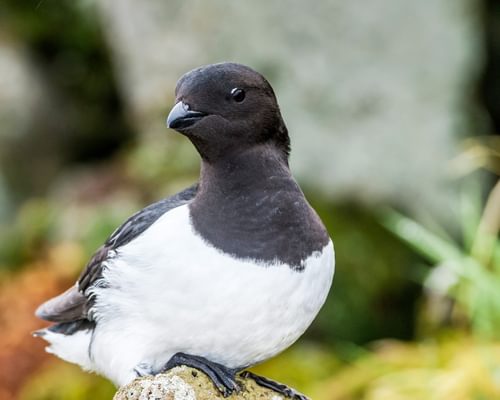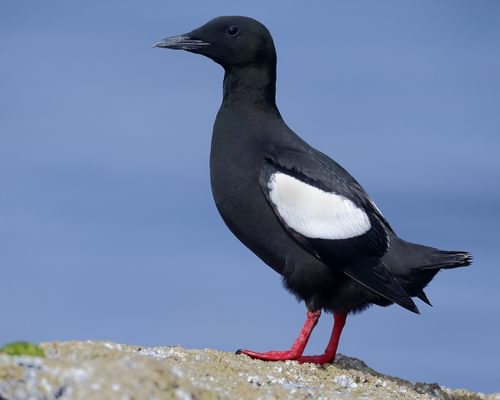Atlantic Puffin
VulnerableFratercula arctica
Visual Identification
Appearance
The Atlantic Puffin is one of the world's most distinctive seabirds. It has a black back, white underparts, and a large, colourful beak.
Its head is black with pale grey cheek patches, and it has a blue-grey eye-ring, and its legs and webbed feet are bright orange. The beak is red and yellow with a blue base during the breeding season.
In winter, the beak becomes smaller and duller, the face turns darker , and the feet turn pale yellow. Juveniles resemble winter adults but have a smaller, darker beak.
Size
Length
28cm to 34cm
Wingspan
50cm to 60cm
Weight
300g to 500g
Colours
Males and females have similar plumage
Primary Colour
Black White
Beak Colour
Red Yellow Blue
Leg Colour
Orange
Habitat and Distribution
Habitats
Woodland
Garden
Wetland
Coastal
Urban
Farmland
Grassland
Desert
Tundra
Rainforest
Mountain
Savanna
Distribution
Atlantic Puffins inhabit the North Atlantic Ocean, breeding on coastal cliffs and islands from Newfoundland and Labrador to Iceland, Norway, and the British Isles. They are particularly abundant in Iceland, which hosts about 60% of the world's breeding population.
During the non-breeding season, puffins disperse widely across the North Atlantic and Arctic Oceans, rarely coming to land. In the UK, significant colonies can be found in Scotland, Wales, and northern England.
Elevation Range
Sea level to 200 meters
Climate zones
Subarctic, Temperate
Distribution Map
This map gives you a rough idea of where you might spot a Atlantic Puffin. The coloured areas show countries where these birds have been seen.
A few things to keep in mind:
- Birds might not be everywhere in the coloured areas, for example, they may be present around the coast of that country
- Where birds live can change with seasons and available food
- This map is quite simple - it doesn't show exact locations
We're working on making our maps even better! Soon, we hope to show you:
- More detailed maps for bigger countries, including state and region
- How birds move around during different seasons
Distribution by Region
Behaviour and Ecology
Bird Attributes
This feature is in beta. We'd love your feedback to improve it!
Share your thoughtsBird Attributes Explained
Our bird attributes system rates various aspects of a bird's capabilities on a scale of 0-100, based on data from field observations, scientific studies, and expert knowledge.
Attribute Categories:
- Agility: Manoeuvrability, speed, and grace in flight or movement.
- Strength: Physical power, often correlating with size and hunting abilities.
- Adaptability: Ability to thrive in various environments or changing conditions.
- Aggressiveness: Territorial behaviour and assertiveness, particularly during breeding seasons.
- Endurance: Stamina, often seen in migration patterns or foraging behaviours.
Understanding the Ratings:
- 0-20: Very Low
- 21-40: Low
- 41-60: Average
- 61-80: High
- 81-100: Very High
Remember, these attributes are relative to other bird species and don't necessarily indicate superiority.
Hover over the icon next to each attribute for more information.
Tap the icon next to each attribute for more information.
Agility
Reflects the bird's manoeuvrability, speed, and grace in flight or movement.
Atlantic Puffins display remarkable agility both in the air and underwater. Their ability to 'fly' underwater, beating their wings up to 400 times per minute, and dive to depths of 60 metres demonstrates exceptional manoeuvrability. On land, they're less graceful, with a distinctive waddling gait.
Strength
Indicates the bird's physical power, often correlating with size and hunting abilities.
While not exceptionally strong for their size, Atlantic Puffins exhibit considerable strength in their underwater pursuits and ability to carry multiple fish (up to 60) crosswise in their beaks. Their capacity to dive deep and withstand water pressure also indicates a robust physique.
Adaptability
Represents the bird's ability to thrive in various environments or changing conditions.
Atlantic Puffins show high adaptability, thriving in both marine and terrestrial environments. They adjust their beak colour and size seasonally and can adapt to various nesting situations, from burrows to rock crevices. Their ability to survive in harsh North Atlantic conditions further demonstrates their adaptability.
Aggressiveness
Measures the bird's territorial behaviour and assertiveness, particularly during breeding seasons.
Atlantic Puffins are not particularly aggressive birds. They are highly social, forming large colonies and engaging in group behaviours. However, they may display some aggression when defending their nesting burrows or competing for mates, hence the moderate score.
Endurance
Reflects the bird's stamina, often seen in migration patterns or foraging behaviours.
These seabirds exhibit exceptional endurance. They can dive repeatedly to significant depths, fly long distances during migration, and spend extended periods at sea. Their ability to withstand harsh North Atlantic conditions and their long lifespan (20-25 years) are testament to their remarkable endurance.
Diet
Atlantic Puffins primarily feed on small fish such as sand eels, herring, and capelin.
They are known for their ability to carry multiple fish crosswise in their beaks, sometimes holding up to 60 fish at once. Puffins also consume some marine invertebrates, including squid and crustaceans.
They have a serrated bill and a tongue, which they use to trap food against their palate, enabling them to open their bills and catch more food.
Behaviour
Atlantic Puffins are excellent swimmers, using their wings to 'fly' underwater while hunting fish. On land, they walk with a waddling gait.
These birds are highly social, nesting in large colonies and engaging in group behaviours like synchronised head-bobbing and bill-tapping during courtship.
Vocalisation
Atlantic Puffins are generally quiet at sea but more vocal at breeding colonies. Their most common call is a low growling sound, often described as 'arr-uh'.
During courtship, they produce a series of deep, throaty purrs. Puffins also make a soft 'haa-haa' sound when returning to their burrows.
Nesting & Breeding
Atlantic Puffins form monogamous pairs for life and return to the same breeding sites year after year. The breeding season typically begins in April or May, with pairs engaging in elaborate courtship displays.
Puffins nest in burrows on grassy clifftops or in crevices among rocks. They lay a single white egg, which both parents incubate for about 39-43 days. The egg often becomes stained brown from the soil.
After hatching, the chick (known as a puffling) remains in the burrow for 6-8 weeks, fed by both parents. Fledging occurs at night to avoid predation, with the young puffin flying directly out to sea.
Lifespan
The Atlantic Puffin typically lives for 20 to 25 years, with a maximum recorded lifespan of 45 years.
Like all birds, lifespan can be affected by factors including predation, habitat quality, disease, and access to food sources.
Conservation and Status
Global Conservation Status
Atlantic Puffins face threats from climate change, overfishing, and pollution. Conservation efforts focus on protecting breeding sites, managing fisheries, and reducing plastic pollution in the oceans. Several organisations work to monitor and protect puffin populations across their range.
Birdwatching Tips
- Look for puffins on coastal cliffs or rocky islands during the breeding season (April to August)
- Use binoculars to spot their distinctive colourful beaks from a distance
- Visit known breeding colonies in the UK, such as the Farne Islands or Skomer Island
- Observe from boats for a chance to see puffins diving or carrying fish
Additional Information
Quick Facts
Other names:
Common Puffin, Sea Parrot
Family:
AlcidaePredators
Main predators include large gulls, skuas, and ravens, which may take eggs or chicks. At sea, puffins are preyed upon by large fish and occasionally seals.
Did You Know?
- Puffins can dive up to 60 meters deep and stay underwater for up to a minute while hunting fish.
- Their beaks change colour seasonally, becoming duller and smaller in winter.
- Puffins' wings are adapted for 'flying' underwater, beating up to 400 times per minute.
Was this bird profile helpful?
Your feedback helps us improve our content
Thanks for your feedback!
Your input helps us improve our content.
Community Experience
Community Ratings
No ratings yet - be the first to rate this bird!
Latest Community Reviews
No reviews yet
Sign in to be the first to review
Community Reviews
Create Your Free Account Welcome Back!
Join our community to rate birds and share your experiences. Creating an account is completely free and only takes a minute. Sign in to your account to rate birds and share your experiences with our community.
Your information is secure and will never be shared.
By creating an account, you agree to our Privacy Policy.
Similar Birds
References
- 2 4
website: BirdLife International. 2018. Fratercula arctica. The IUCN Red List of Threatened Species 2018: e.T22694927A132581443.
View source - 3
report: Harris and Wanless 2011; Berglund and Hentati-Sundberg 2014
- 1
website, 2010: Fransson et al., EURING list of longevity records for European birds
View source

